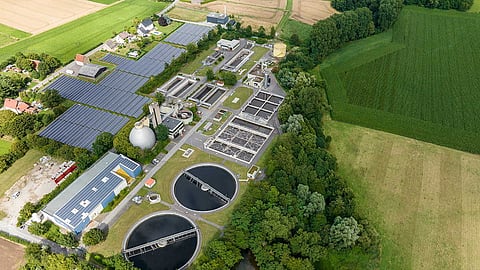
- Home
- EventsEvents
- Product Launches
- CategoriesCategories
- Advertise
- Opinion

By supplying two heat pumps, GEA is helping the city of Lemgo on its way to achieving climate neutrality by 2035. The GEA technology will generate heat from the effluent of the city's wastewater treatment plant, waste heat from a large combined heat and power (CHP) plant and from the River Bega.
The heat generated by the large heat pumps is sufficient to supply the historic city center of Lemgo with low-carbon heat as far as possible. That's around 18 million kilowatt hours of heat per year, which saves 3,200 tons of CO₂ emissions per year. The heat from the wastewater treatment plant's effluent alone can cover two thirds of the old town's heating requirements or twelve percent of the district heating network's total demand. The operating strategy ensures that the heat pumps can operate constantly for up to 7,500 hours per year to maximize the benefits of the heat pumps.
GEA's Malmö project attracted attention - individual solution developed in coordination for GEA municipal utilities
Stadtwerke Lemgo became aware of GEA through the "Malmö" heat pump project. Here, too, GEA technology was used to generate heat from the waste water of a municipal sewage treatment plant in the Swedish metropolis. At an initial meeting on site in Lemgo, GEA suggested to the customer that the initially planned low-pressure heat pump and high-pressure heat pump be replaced by a two-stage heat pump without a lossy intermediate circuit. This was quickly recognized by all parties involved as the significantly more advantageous option in terms of energy and economy. So only this variant was pursued further. At the time, there was no comparable solution from competitors on the market.
Generating heat from the wastewater of the Lemgo municipal sewage treatment plant
The recovery of heat from the waste water of the municipal central sewage treatment plant in Lemgo forms an important part of the municipal district heating generation. The clean water at the sewage treatment plant outlet is highly suitable. The treated wastewater has an average annual temperature of around 13° C. Due to the mixed water system, large quantities of water (equal to quantities of heat!) are available. More than 1.5 MW of source power is available for almost 8,000 h/a. Furthermore, infrastructure such as a combined heat and power plant and district heating connection are available at the sewage treatment plant. Heat is only extracted downstream of the treatment stages at the outlet of the sewage treatment plant. This enables the highest possible amount of heat to be generated with relatively little technical effort. The wastewater treatment process is also not affected by the heat extraction.
The biggest challenges for Stadtwerke Lemgo and GEA - and how they were overcome
Upon commissioning, it was discovered that the water quality of the heat source from the sewage treatment plant did not meet the original purity expectations. The resulting contamination of the evaporators meant that the "pure water heat pump" could no longer continue to operate. The task now was to find a sustainable solution. Of the options considered, joint deliberations between Stadtwerke Lemgo and GEA rejected the possibility of an additional separating heat exchanger or the conversion of the heat pump and tube bundle evaporator with a complex self-cleaning system. The decision was made in favor of an additional filtration system, which was then implemented.
Natural refrigerant ammonia another plus point for environmental protection
The fact that the GEA heat pumps are also operated with the natural refrigerant ammonia is another plus point in terms of environmental protection. Ammonia is an inorganic compound of nitrogen and hydrogen, lighter than air and easily soluble in water. GEA is a leader in the development of technology solutions for natural refrigerants such as ammonia in order to achieve the environmental targets for phasing out the use of fluorinated gases (F-gases) and reducing emissions released into the atmosphere. The COP (coefficient of performance) of an ammonia heat pump operating under typical conditions for a district heating network or for process heat below 100 °C, for example, is 40 % higher compared to synthetic refrigerants, which means 40 % fewer emissions, 40 % less energy and 40 % lower costs.
A milestone achieved - but by no means the "end of the line"
Stadtwerke Lemgo is not yet satisfied with what it has achieved. They are already planning the next steps towards a CO₂-neutral electricity and heat supply for the town: By 2028, more than 55 percent of the district heating required is to be generated from renewable sources. The Lemgo team is relying on a large-scale solar thermal system, another large heat storage tank with an integrated PtH and air heat pump. These will be connected by direct cable to a wind turbine, which is also in the planning stage, in order to generate wind heat. In addition, a wind power plant will contribute to hydrogen production - further investments are planned in a biomass boiler and a wood gasification plant for road side wood in order to achieve the goal of climate neutrality.
Click HERE to subscribe to our FREE Weekly Newsletter
